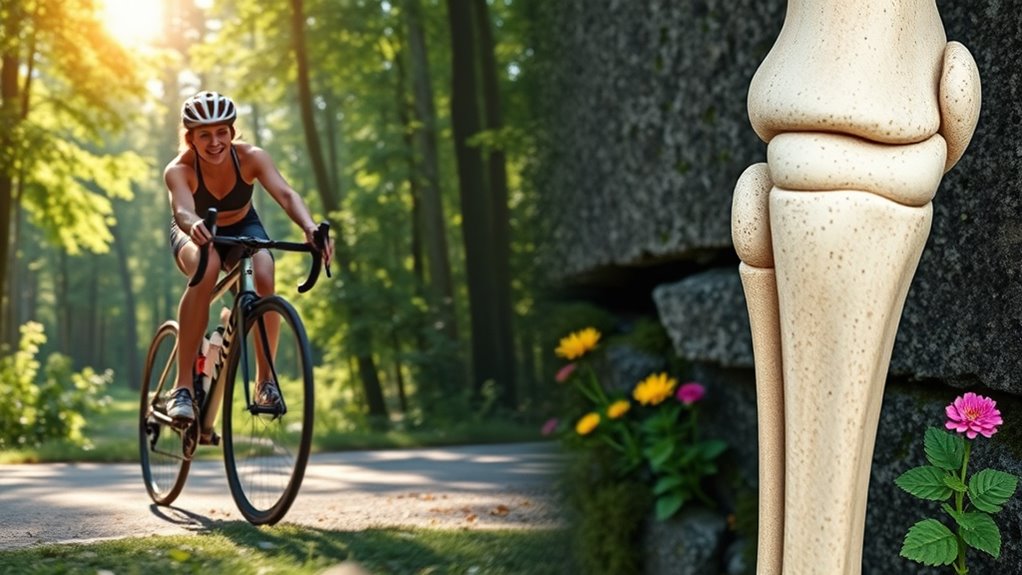Many believe cycling weakens bones because it’s a non-weight-bearing exercise, but that’s a myth. While cycling alone doesn’t stimulate bone growth as much as weight-bearing activities, it still benefits your circulation and muscle engagement, which support bone health. Combining cycling with activities like walking, jumping, or resistance training can keep your bones strong. Keep exploring to discover effective strategies that help you maintain healthy bones while enjoying your rides.
Key Takeaways
- Cycling is a low-impact activity that does not significantly stimulate bone formation, but it doesn’t weaken bones when combined with other exercises.
- Myth: Cycling causes bone loss; fact: proper nutrition and weight-bearing exercises are essential for maintaining bone density.
- Cycling improves circulation and muscle engagement, which can support bone health when complemented with resistance and impact activities.
- Incorporating weight-bearing exercises like walking or resistance training alongside cycling optimizes bone strength.
- Adequate calcium, vitamin D intake, and proper equipment support overall skeletal health, regardless of cycling’s low-impact nature.
Understanding Bone Density and Its Importance
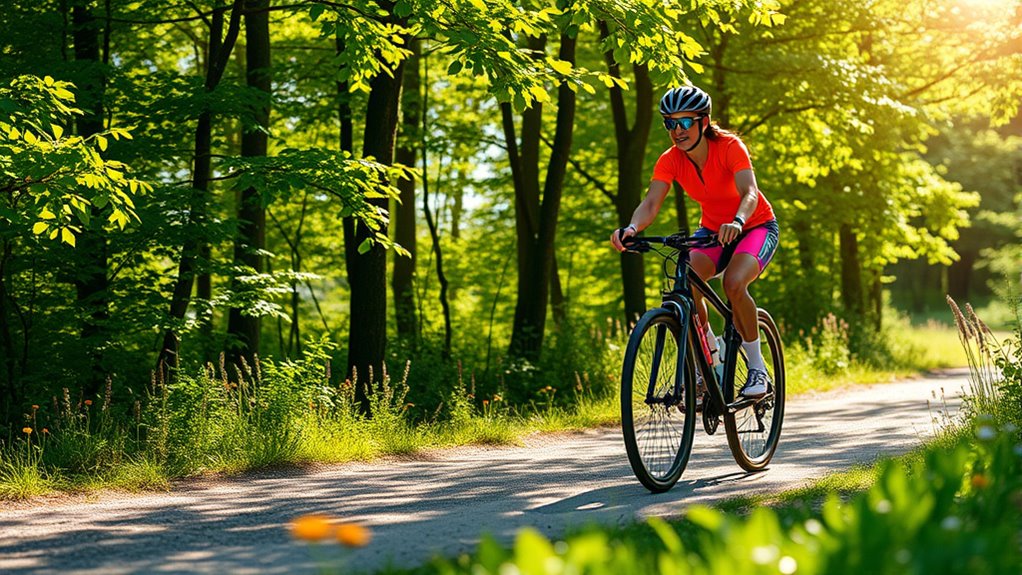
Bone density measures how strong and solid your bones are, playing a crucial role in preventing fractures and osteoporosis. Maintaining healthy bone density is essential for osteoporosis prevention, especially as you age. A higher bone density means your bones can better withstand stress and impact, reducing the risk of breaks. To assess your bone health, healthcare providers use bone density measurement tests like DEXA scans. These tests help identify early signs of bone loss before symptoms appear, allowing you to take proactive steps. Understanding your bone density gives you valuable insight into your overall health and guides your lifestyle choices. Incorporating weight-bearing exercises, proper nutrition, and regular check-ups supports maintaining or improving your bone density, helping you stay active and fracture-free. Being aware of factors such as hormonal influences and lifestyle habits can also affect your bone health and should be considered in your prevention strategies.
How Cycling Affects Bone Health
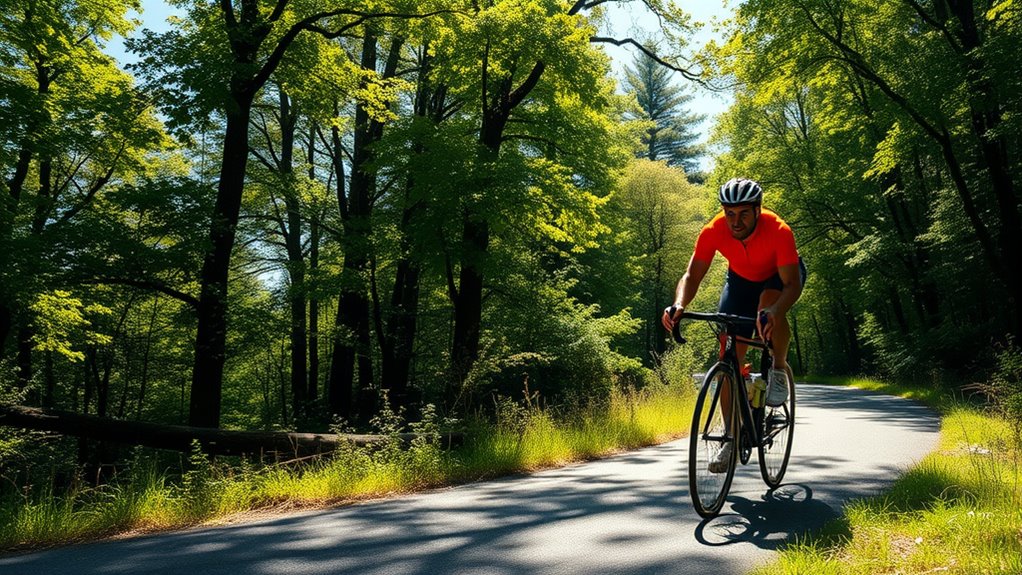
While cycling is an excellent low-impact exercise for cardiovascular health, its effects on bone density are more nuanced. Cycling primarily engages the leg muscles, providing some muscle engagement that supports bone strength, but it doesn’t generate the same stress on bones as weight-bearing activities. This means you get significant cardiovascular benefits without the same bone stimulation. Without enough impact, bones might not adapt and strengthen as effectively. However, incorporating varied routines, like resistance training, can complement cycling and promote better bone health. While cycling helps improve overall fitness and muscle engagement, it’s not enough alone to maximize bone density. Balancing cycling with weight-bearing exercises is key if you want to maintain or improve your bone health while enjoying the benefits of cycling.
The Science Behind Weight-Bearing vs. Non-Weight-Bearing Exercises
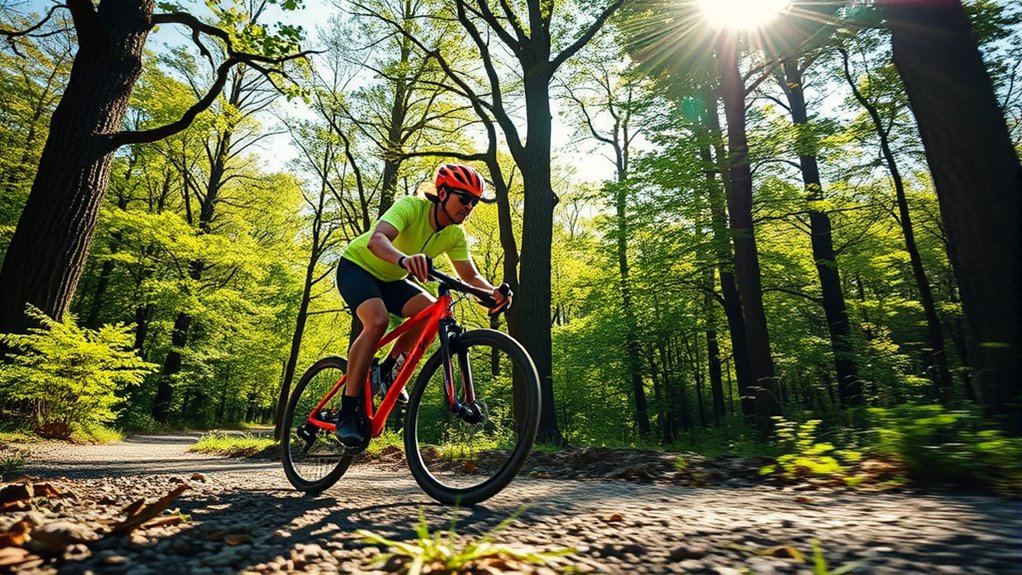
You might wonder how different exercises affect your bones’ strength. Weight-bearing activities, like running or jumping, stimulate bone growth more than non-weight-bearing ones like cycling. Understanding these differences helps you choose the right exercise for maintaining healthy bones.
Impact on Bone Strength
Weight-bearing exercises, such as running or resistance training, directly stimulate bone formation by applying mechanical stress that encourages bone remodeling and strengthening. This process enhances bone strength, helping to prevent fractures and reduce osteoporosis risk. When you engage in these activities, your bones respond by increasing mineral density and structural integrity. Imagine:
- Your bones adapting like steel beams supporting a building
- Tiny microfractures signaling repair, making bones tougher
- Mechanical stress triggering cells to deposit new mineralized tissue
- Regular impact strengthening bones against future fractures mechanical stress
This mechanical stimulation is key for maintaining ideal bone strength and resilience. While cycling is excellent for cardiovascular health, weight-bearing activities are essential to promote bone density, ultimately aiding in fracture prevention and lowering osteoporosis risk. Additionally, understanding how sound design techniques can be used to create immersive educational content about bone health can enhance public awareness and engagement. Recognizing the importance of bone adaptation can motivate consistent participation in weight-bearing exercises for long-term skeletal health.
Exercise Types Comparison
Understanding the differences between weight-bearing and non-weight-bearing exercises is essential for optimizing bone health. Weight-bearing activities, like resistance workouts and certain interval training, stimulate bone growth by applying impact forces. Non-weight-bearing exercises, such as cycling, reduce joint stress but don’t provide the same bone-stimulating benefits. Incorporate a mix of both for balanced health. Here’s a quick comparison:
| Feature | Weight-Bearing Exercises | Non-Weight-Bearing Exercises |
|---|---|---|
| Impact on bones | High | Low |
| Examples | Resistance workouts, running | Cycling, swimming |
| Bone density benefits | Significant | Limited |
Striking a balance ensures you strengthen bones while protecting joints. Regularly engaging in weight-bearing exercises can help improve collagen production, which is vital for maintaining healthy bone structure.
Common Myths About Cycling and Bones
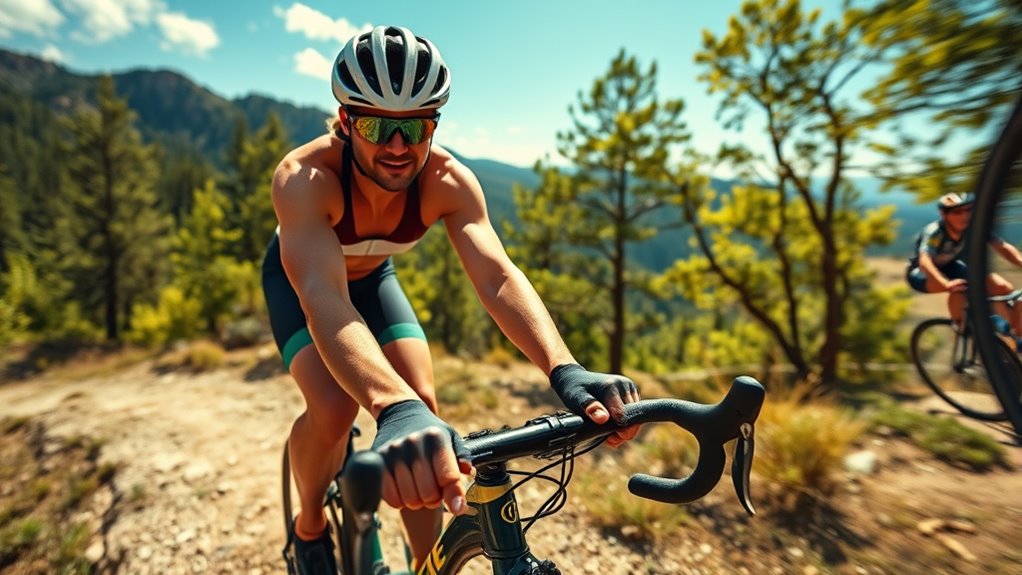
Many people believe that cycling weakens bones because it’s not a weight-bearing activity, but this is a common misconception. Myth busting shows that cycling’s impact on bones isn’t as simple as it seems. You might picture:
- Your bones remaining stagnant while your muscles pedal furiously
- Cyclists with fragile bones despite regular riding
- Weight-bearing exercises being the only way to strengthen bones
- Cycling’s benefits limited to cardiovascular health only
These bone myths overlook how cycling influences bone density through muscle engagement and increased circulation. While weight-bearing activities help, cycling isn’t inherently bad for your bones. Instead, it can be part of a balanced routine that supports bone health. Fabric decorating markers can also be used to personalize cycling gear, making your workout more enjoyable. Real Couples also demonstrate that sharing activities and maintaining a healthy lifestyle can positively affect overall well-being. Don’t fall for these bone myths—cycling’s effects are more nuanced than you think.
Complementary Activities to Support Bone Strength
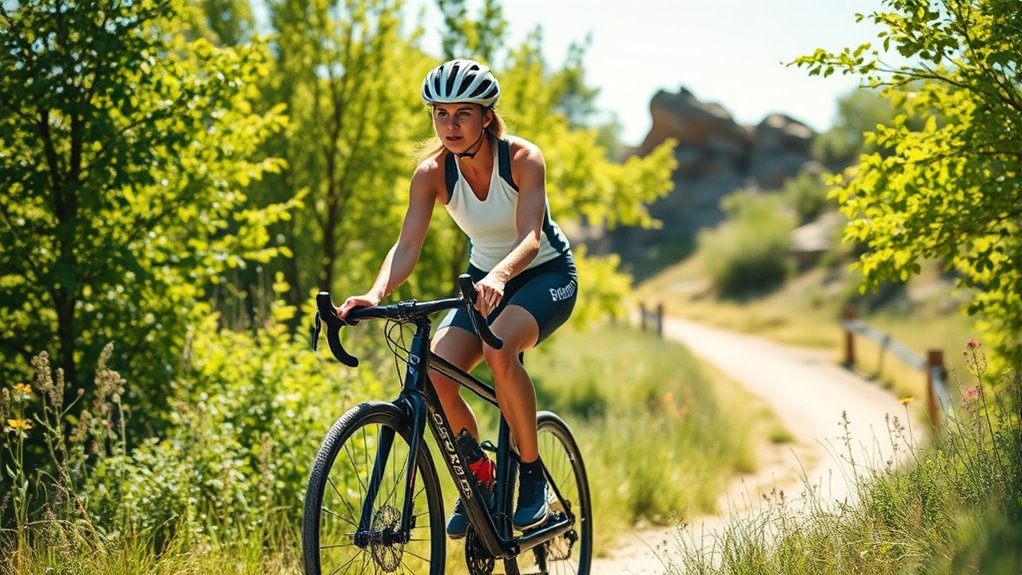
To boost your bone strength, consider incorporating weight-bearing exercises into your routine, like walking or resistance training. Make sure you’re getting enough calcium through your diet or supplements, and spend time in the sun to help your body produce vitamin D. These activities work together to support healthier, denser bones alongside your cycling. Additionally, maintaining proper placement of your exercise equipment can help create a safe environment that encourages consistent activity. As the demand for electric dirt bikes and accessories grows, developing skills in protecting digital assets can also be a valuable component of a comprehensive health and safety strategy. Incorporating nutrient-rich smoothies into your diet, such as those with added fruits or herbs, can further support bone health by providing essential vitamins and minerals.
Weight-Bearing Exercises
Weight-bearing exercises play a crucial role in maintaining and enhancing bone density, especially when combined with cycling. These activities promote muscle engagement and improve joint flexibility, which are essential for strong bones. As you perform weight-bearing movements, you’ll feel your muscles working to support and stabilize your body, creating beneficial stress on your bones. Imagine yourself:
- Running or jogging on a trail, feeling the impact with each step
- Jumping rope, engaging your calf and thigh muscles
- Hiking uphill, strengthening your lower body through resistance
- Dancing, combining movement and balance for joint mobility
These exercises make your bones adapt and grow stronger over time, complementing the low-impact nature of cycling. Incorporating weight-bearing activities into your routine ensures thorough support for your skeletal health. Additionally, choosing dog names that reflect your active lifestyle can motivate you to stay consistent with your exercise routine. Engaging in bone-strengthening activities regularly can significantly improve your overall skeletal resilience and help prevent osteoporosis as you age. proper nutrition, such as adequate calcium and vitamin D intake, further supports your bone health and enhances the benefits of your exercise regimen. Including various forms of weight-bearing exercises, like resistance training or stair climbing, can provide even more comprehensive benefits for your bones.
Adequate Calcium Intake
Making sure you get enough calcium is vital for supporting strong bones, especially when engaging in activities like cycling that promote bone health. Calcium absorption depends on your intake of dietary sources rich in calcium, such as dairy products, leafy greens, and fortified foods. Consuming sufficient calcium helps maintain bone density and reduces the risk of fractures. To maximize absorption, spread your calcium intake throughout the day rather than consuming large amounts at once. Incorporate a variety of dietary sources to meet your daily calcium needs and support overall bone strength. While cycling is a low-impact activity, adequate calcium intake guarantees your bones stay resilient. Remember, consistent consumption of calcium-rich foods plays an essential role in complementing your exercise routine and promoting long-term bone health. Additionally, understanding your body’s nutrient needs can guide you in making informed dietary choices that support your skeletal health. Practicing mindfulness and stress reduction can also positively influence bone density by lowering cortisol levels that may weaken bones over time. Ensuring proper nutrient balance in your diet further enhances your bone strength and overall health. Incorporating adequate vitamin D is also crucial, as it aids in calcium absorption and bone mineralization. Developing a balanced diet with a focus on nutrient absorption can optimize the benefits of calcium intake for your bones.
Vitamin D Enhancement
Have you considered how vitamin D boosts your bones’ ability to absorb calcium effectively? Without enough vitamin D, your body struggles to maintain *ideal* bone mineral density, increasing your fracture risk. To enhance your vitamin D levels, consider activities and habits like:
- Spending time outdoors in sunlight to naturally stimulate vitamin D synthesis
- Including fatty fish such as salmon or mackerel in your diet
- Taking supplements if your levels are low, as advised by your healthcare provider
- Ensuring adequate intake of fortified foods like dairy or plant-based alternatives
- Incorporating weight-bearing exercises into your routine to further support bone health
These actions help your body maximize calcium absorption, strengthening your bones and reducing fracture risk. Maintaining proper vitamin D levels directly supports bone mineral density, making your bones more resilient against fractures as you cycle and stay active.
Practical Tips for Cyclists to Maintain Healthy Bones
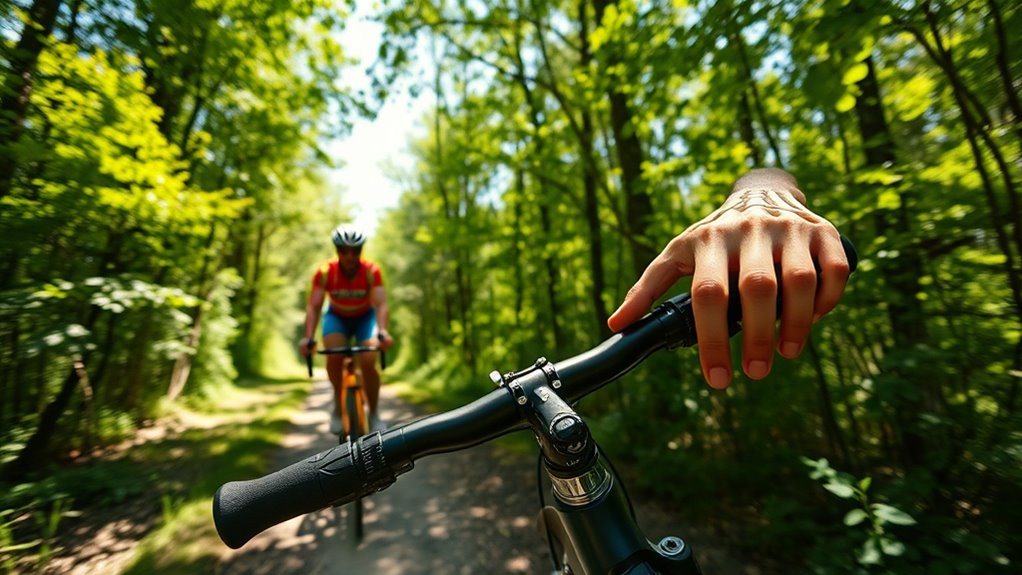
To keep your bones strong while cycling, it’s important to incorporate strategies that complement your aerobic activity. Focus on nutrition tips like consuming calcium-rich foods such as dairy, leafy greens, and fortified products, and include vitamin D sources to aid calcium absorption. Proper cycling gear can also support bone health; wear well-fitting shoes with adequate support to prevent unnecessary stress on your bones. Incorporate weight-bearing exercises like walking or resistance training on rest days, as they help stimulate bone growth. Stay consistent with your diet and exercise routine, and consider supplements if your intake isn’t sufficient. Monitoring your nutrition and gear choices guarantees your bones remain strong despite the low-impact nature of cycling. Additionally, incorporating body awareness and posture techniques can help prevent strain and promote overall skeletal health.
Integrating Cycling Into a Bone-Healthy Lifestyle

Incorporating cycling into a bone-healthy lifestyle involves more than just riding regularly; it requires thoughtful planning and balanced habits. You should focus on cycling nutrition to support bone health, ensuring your diet includes calcium and vitamin D. Proper bike maintenance is essential to prevent injuries and keep your rides safe and effective. To integrate cycling successfully, consider these habits:
- Maintain your bike regularly for smooth, safe rides
- Fuel up with nutrient-rich foods that strengthen bones
- Incorporate weight-bearing exercises alongside cycling
- Plan varied routes to add impact and challenge
Frequently Asked Questions
Can Cycling Alone Prevent Osteoporosis in Older Adults?
You might wonder if cycling alone can prevent osteoporosis in older adults. While cycling boosts cardiovascular health, it’s not enough for strong bones. To truly protect yourself, include weight-bearing exercises like walking or resistance training. Also, guarantee proper Vitamin D supplementation to improve calcium absorption. Combining these strategies helps strengthen bones and reduces osteoporosis risk, making your overall approach more effective than cycling alone.
Are There Specific Bike Types Better for Bone Health?
When choosing a bike for bone health, consider the bike frame and saddle type. A sturdy, weight-bearing bike frame like a mountain bike or hybrid encourages more active engagement, which benefits bones. Opt for a saddle that offers good support and encourages proper posture, reducing strain. These choices can enhance the impact of cycling on your bone density, making your ride more effective for maintaining or improving bone strength.
How Does Cycling Impact Bone Density Compared to Running?
You might wonder about the impact differences between cycling and running on bone density. Running provides higher bone strengthening benefits because it’s a weight-bearing activity, which stimulates bone growth. Cycling, on the other hand, has less impact on bones due to its low-impact nature, making it less effective for increasing bone density. To optimize bone health, consider combining cycling with weight-bearing exercises like running or strength training.
What Nutritional Factors Are Crucial for Cyclists’ Bone Health?
To support your bone health, focus on key nutritional factors like calcium and vitamin D. Calcium absorption is essential for maintaining strong bones, so include dairy products, leafy greens, and fortified foods in your diet. Additionally, vitamin D helps your body absorb calcium efficiently, so get enough sunlight or consider supplements if needed. Proper nutrition guarantees your cycling efforts strengthen bones rather than weaken them.
Is There a Recommended Cycling Frequency for Optimal Bone Strength?
You should aim to cycle at least three to five times a week for ideal bone strengthening benefits. Consistent cycling helps improve bone density, but mixing in weight-bearing activities can maximize your cycling benefits for stronger bones. Remember, balance is key—too much cycling without other weight-supporting exercises might not fully optimize bone health. Stay active regularly, and you’ll support your bones while enjoying the many benefits of cycling.
Conclusion
So, as you cycle through your daily routine, remember it’s no coincidence that combining your rides with weight-bearing exercises can boost your bone health. Embrace the rhythm of your pedaling and strength training, and you’ll find that maintaining healthy bones becomes a natural part of your active lifestyle. With a little planning, you’ll enjoy stronger bones and better overall health—making every turn of the pedal a step toward a more resilient you.
